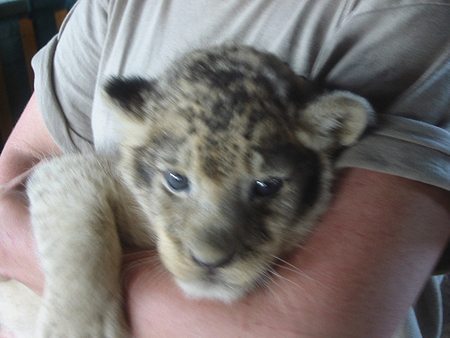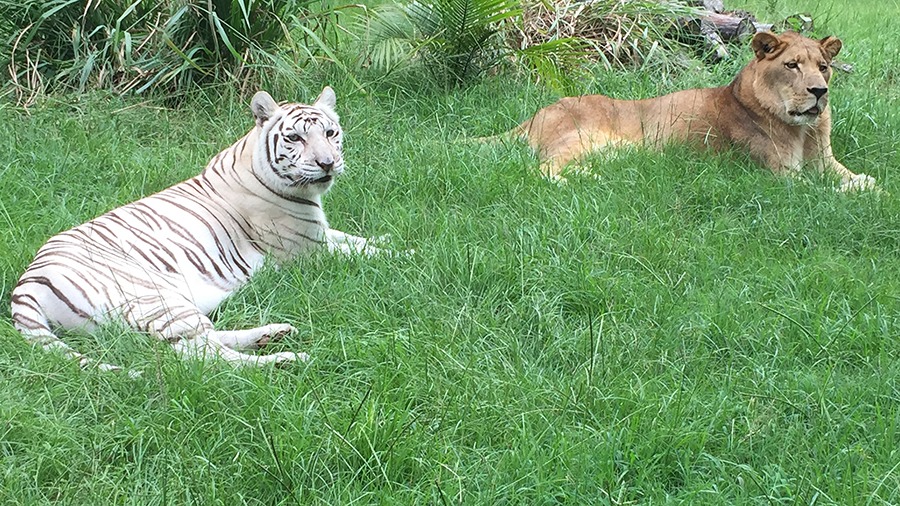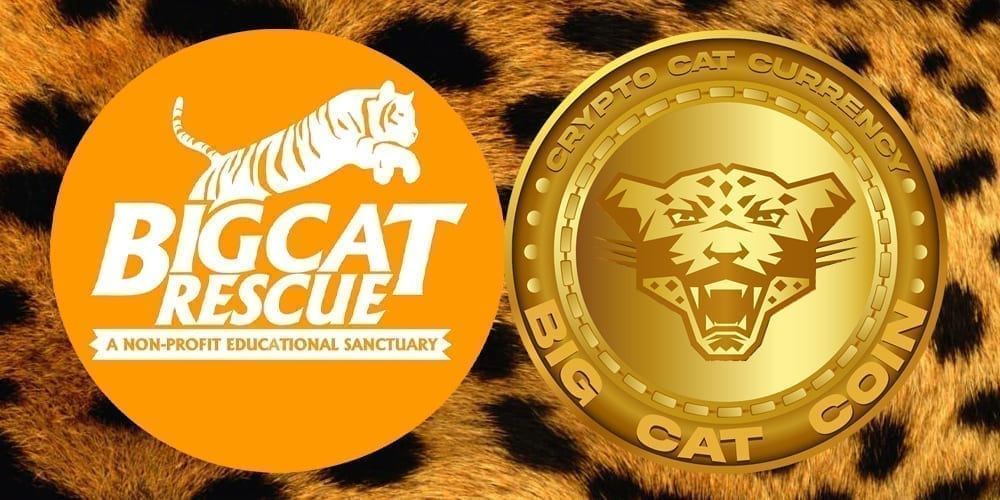Dying To Be Held
Dying To Be Held
 If we were only $20.00 away from curing cancer, we would surely all clamor to be the one to complete the fundraising for the cure. Some of the ills of our society are that close to a cure. Ending the abuse of baby lions and tigers is one of them.
If we were only $20.00 away from curing cancer, we would surely all clamor to be the one to complete the fundraising for the cure. Some of the ills of our society are that close to a cure. Ending the abuse of baby lions and tigers is one of them.
In 2005 The Chronicles of Narnia’s computer generated animation of Aslan the lion captivated the imagination of all who witnessed the fantasy. The notion of being so special that the creature known as the King of Beasts would allow us to touch him became irresistible to many when they were allowed to act out their fantasy. It only cost them $20.00… and their conscience.
After paying $20.00 to have their picture made with a baby lion or tiger the vast majority of people, who learned the truth about the miserable lives captive cats lead, confess “I knew in my heart that there was something wrong…” Often it is the nagging conscience, reminding them of the distressed baby’s cries for their real mothers, the barren accommodations, and the sleaziness of the business operators that haunted them long after the thrill of the moment had passed.
Most of the “pay to play” operations stay on the move. They set up in flea markets, fair grounds and parking lots for only a few days at a time. They frequently change their names and rarely own a facility anywhere that is open to public scrutiny. Then know that their pitch of doing this for education or conservation can easily be disproved. By the time they are found out, they are on the road again. In 2005 there were far too many lion and tiger babies bred just for this purpose and those who paid to touch them would be appalled if they knew how life has turned out for those innocent cubs.
 Big cats can breed several times a year, giving birth to 2-6 cubs. The cubs are immediately pulled and bottle raised so that the mothers can be bred again. It was not unusual to see a circus-type side show offering the public the chance to handle cubs who were only days old. To keep the cubs small they are often starved, and deprived of the calcium and vitamins needed to build big, healthy bodies. In some cases cubs have been purposely poisoned to give them diarrhea so that they cannot put on any weight. Pound for pound a big cat is 12 times stronger than a man, so keeping them small and handlable is the main objective for these abusers. When they get too big to use, they disappear and there is virtually no way to track them. If the dealer has 10 tigers this year and 10 tigers next year, then it appears as if no births and no disappearances have happened, so no further investigation takes place. It is no coincidence that the US is the second largest consumer of illegal, black market tiger parts.
Big cats can breed several times a year, giving birth to 2-6 cubs. The cubs are immediately pulled and bottle raised so that the mothers can be bred again. It was not unusual to see a circus-type side show offering the public the chance to handle cubs who were only days old. To keep the cubs small they are often starved, and deprived of the calcium and vitamins needed to build big, healthy bodies. In some cases cubs have been purposely poisoned to give them diarrhea so that they cannot put on any weight. Pound for pound a big cat is 12 times stronger than a man, so keeping them small and handlable is the main objective for these abusers. When they get too big to use, they disappear and there is virtually no way to track them. If the dealer has 10 tigers this year and 10 tigers next year, then it appears as if no births and no disappearances have happened, so no further investigation takes place. It is no coincidence that the US is the second largest consumer of illegal, black market tiger parts.
In 2007 USDA adopted a policy stating that baby big cats, under the age of 8 weeks and over the age of 16 weeks, could not be handled by the public. They also define a big cat as lions, tigers, jaguars, leopards, mountain lions, and cheetahs. Florida and some other states still classify a mountain lion as a small cat and allow them to be kept as pets, despite the fact that they can grow to be over 200 lbs and are very dangerous.
Many pseudo sanctuaries breed their big cats to attract donors and to lure volunteers who want to play with the babies. But in 2007 the US Fish and Wildlife Service announced: “Accredited wildlife sanctuary means a facility that cares for live specimens of one or more of the prohibited wildlife species and:
(1) Is approved by the United States Internal Revenue Service as a corporation that is exempt from taxation under Sec. 501(a) of the Internal Revenue Code;
(2) Does not commercially trade in prohibited wildlife species, including offspring, parts, and products;
(3) Does not propagate any of the prohibited wildlife species; and
(4) Does not allow any direct contact between the public and the prohibited wildlife species. (prohibited wildlife species incl. lions, tigers, leopards, snow leopards, clouded leopards, jaguars, cougars and cheetahs).
(Legitimate sanctuaries meet or exceed the minimum requirements at SanctuaryStandards.com)
A lot can change in three years and there have been fewer and fewer news reports hawking the fun of touching a baby wild cat. Venues are becoming more aware of the public disdain for the practice and no longer want to be associated with what is now commonly viewed as cruelty. Every year there is a parade in Pinellas County, FL where a local man takes his tigers, bears and other exotic animals out in circus wagons as part of the spectacle. It has been a tradition that has gone from being accepted to being booed in just the last year. The operation owner and wildlife trapper, Vernon Yates was quoted in the St. Pete Times as saying, “I thought I would not see it in my lifetime but I think it’s coming — any form of private (exotic animal) ownership will be gone.” The public has become better informed and not only is refusing to support this abuse, but many people are coming forward to end it.
Innkeepers at the Sobotta Manor Bed and Breakfast, Robin and Thurman Hester, wrote Big Cat Rescue asking for help, saying, “I am an Innkeeper in Mount Airy North Carolina where an organization called The Zoo (owned by Pat & Robert Engessor) visited a few days back and they had as part of their show an eight week old tiger cub that was being handed to person after person to have photos made and was crying as in pain the entire time. Additionally when the cat was placed back in the pen it was too ill to even walk and had severe dysentery. They would just rinse its rear and hand to the next person. The condition of this baby was awful and I am afraid for its life. My friend, as well as others, witnessed the condition of this cub. I am from Tampa and am familiar with your organization and hope you can assist.”
Paula Sabatke writes, “I live in northern Wisconsin and visited the Big Cat Rescue for the first time in December, although I have been a fan for years. I am sure that you hear these stories all to often, but I would like your help. This past weekend I attended a professional conference in the Wisconsin Dells at a large resort, the Kalahari. In the lobby, a private vendor was set up with a very young white tiger cub in a small glass enclosure. For a fee, one could pay to have a picture taken with the cub. This cub was about the size of a large house cat and could barely stand on its own. While I took the opportunity to tell anyone who would listen what a terrible and inhumane situation this was, I felt that I should be doing something more. Can you offer any suggestions?”
 One of the heretofore most popular tourist attractions in Africa was the opportunity to pet baby lions. The operators of these lion farms have sold themselves as being conservation breeding programs so that people would feel good about doing something that they know in their hearts to be wrong. The Drakenstien Lion Park urges people to consider these facts, “These inbred, human imprinted and psychologically damaged animals have absolutely no conservation value. They cannot be rehabilitated into the wild. They cannot be used to supplement dwindling wild populations.” The lion park, which rescues some cast off captive bred lions, further explains that the only use for these cubs, after they have grown up, is by the canned hunting ranches and says, “Every reputable animal welfare organization in the world considers the practice of using lion cubs for human playthings as cruelty.”
One of the heretofore most popular tourist attractions in Africa was the opportunity to pet baby lions. The operators of these lion farms have sold themselves as being conservation breeding programs so that people would feel good about doing something that they know in their hearts to be wrong. The Drakenstien Lion Park urges people to consider these facts, “These inbred, human imprinted and psychologically damaged animals have absolutely no conservation value. They cannot be rehabilitated into the wild. They cannot be used to supplement dwindling wild populations.” The lion park, which rescues some cast off captive bred lions, further explains that the only use for these cubs, after they have grown up, is by the canned hunting ranches and says, “Every reputable animal welfare organization in the world considers the practice of using lion cubs for human playthings as cruelty.”
Carole Baskin, Founder of Big Cat Rescue reports, “We respond to every one of these complaints and urge the witness to take pictures, videos and written statements about what they saw to the USDA, to the state agencies that monitor wildlife, and to the media to expose the awful way these great cats are being treated.” They have been doing it and there has been a tremendous shift in the way people are thinking about and treating wild animals.
When the next Aslan the lion movie, Prince Caspian, opened in theaters May 17, 2008 there did not appear to be even one baby lion or baby tiger photo booth advertised across the nation. “We monitor the keywords: lion, tiger, cub, big cat and others via google news alerts and we closely monitor sites like www.911AnimalAbuse.com which is a site that allows people who have witnessed animal abuse to post a letter, photos and video while contacting USDA and the agencies mentioned above at the bottom of every page. We didn’t see one report of a baby lion or baby tiger being used as a prop in conjunction with the opening of the movie,” says Carole Baskin.
 So near and yet so far. Exotic and endangered animals are increasingly in the mainstream news as experts such as the 43 member, International Tiger Coalition and the World Bank announced a launch in June of 2008 to save the tiger from extinction. These same groups compiled a petition of more than 125,000 signatures to ban tiger farming. And yet, at a restaurant in Florida on Memorial Day Weekend, the special was “lion steak” for $48.95 a plate because the lion, although in considerable peril, is not yet classified as endangered. To quote Harrison Ford in his public service announcement for Wildaid, a member of the International Tiger Coalition, “When the buying stops, the killing can too.”
So near and yet so far. Exotic and endangered animals are increasingly in the mainstream news as experts such as the 43 member, International Tiger Coalition and the World Bank announced a launch in June of 2008 to save the tiger from extinction. These same groups compiled a petition of more than 125,000 signatures to ban tiger farming. And yet, at a restaurant in Florida on Memorial Day Weekend, the special was “lion steak” for $48.95 a plate because the lion, although in considerable peril, is not yet classified as endangered. To quote Harrison Ford in his public service announcement for Wildaid, a member of the International Tiger Coalition, “When the buying stops, the killing can too.”
A final quote from Baskin sums it up,”We are standing right on the edge of the societal shift toward being more compassionate. There is a bill before congress that will end the public contact with big cats and their babies and thousands upon thousands of people have written their lawmakers to support this bill to protect the babies from being bred, used and discarded as petting props. It is called Haley’s Act (HR 1947) and is named after a 17 year old girl who was mauled to death by a tiger while posing for a photo. You can write a letter in support of the new law at www.CatLaws.com You can end this kind of animal abuse in your lifetime. The cure is only $20.00 and a letter away. Don’t pay to play with a baby big cat and write your Congress today!”
Rule Changes in Florida Comment by July 4, 2008
Even if you are not from Florida, this could make a big difference where you live because Florida currently produces more big cats than any other state. These cats are hauled all over the country, and sometimes even to foreign countries where people are not as concerned with protecting animals. When the cats cats can no longer be used to support their owners they are often dumped along the way; sometimes into the hands of unwitting exotic pet owners and sometimes into the wild. Ending the trafficking of exotic cats in Florida will greatly reduce the number of these cats who end up suffering in all parts of the world.
Dear Carole:
The view from here is similar. From my first awareness of the problem about 30 years ago until just a few years ago, it just seemed to get worse & worse. At one point in 1996-1997 I knew of more than 100 big cats who were in urgent need of sanctuary space & were on waiting lists.
These days the list is down to just a few at a time — but the big problem now looks to me like sanctuaries (both actual & alleged) running out of money & luck & suddenly dumping dozens to hundreds of big cats all at once. We have already seen several cases, & as the economy worsens, I suspect we’ll see more.
The good news is that the sanctuaries that are thriving are mostly head-&-shoulders better than any that existed 10-20 years ago. We’re mostly past the era of the corn crib cage & cats walking in endless circles, like merry-go-rounds without riders — knock on wood!
I am a bit anxious about the possibility that umpteen more tiger breeders will suddenly pop up, selling cubs at flea markets. After so long a struggle, it is hard to imagine that this phase of it is mostly over. It is not time to declare victory and quit — but it is time to recognize that great progress has been made, & to press on to complete the job.
—
Merritt Clifton
Editor, ANIMAL PEOPLE
P.O. Box 960
Clinton, WA 98236
Telephone: 360-579-2505
Fax: 360-579-2575
E-mail: anmlpepl@whidbey.com
Web: www.animalpeoplenews.org






